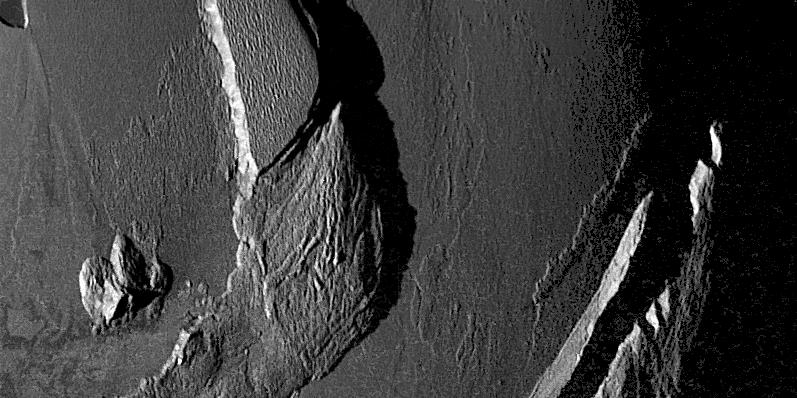
Click to download TIFF (135 kb)

This image taken by NASA's Galileo spacecraft during its close flyby of Jupiter's moon Io on November 25, 1999 shows some of the curious mountains found there. The Sun is illuminating the scene from the left, and because it is setting, the Sun exaggerates the shadows cast by the mountains. By measuring the lengths of these shadows, Galileo scientists can estimate the height of the mountains. The mountain just left of the middle of the picture is 4 kilometers (13,000 feet) high and the small peak to the lower left is 1.6 kilometers (5,000 feet) high.
These mountains, like others imaged during a previous Galileo flyby of Io in October, seem to be in the process of collapsing. Huge landslides have left piles of debris at the bases of the mountains. The ridges that parallel their margins are also indicative of material moving down the mountainsides due to gravity.
North is to the upper left of the picture. The image, centered at -8.1 degrees latitude and 78.7 degrees longitude, covers an area approximately 210-by-110 kilometers (130-by-70 miles). The resolution is 267 meters (880 feet) per picture element. The image was taken at a range of 25,000 kilometers (16,000 miles) by Galileo's onboard camera.
Image produced by: Zibi Turtle and Alfred McEwen, Planetary Image Research Lab. (PIRL), Lunar and Planetary Lab. (LPL), University of Arizona
The Jet Propulsion Laboratory, Pasadena, CA manages the Galileo mission for NASA's Office of Space Science, Washington, DC. JPL is a division of the California Institute of Technology, Pasadena, CA.
This image and other images and data received from Galileo are posted on the World Wide Web, on the Galileo mission home page at http://galileo.jpl.nasa.gov/. Background information and educational context for the images can be found at http://galileo.jpl.nasa.gov/images/io/ioimages.html.
NASA's Planetary Photojournal PIA-02520
December 17, 1999